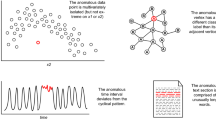Abstract
Bounds of association coefficients for binary variables are derived using the arithmetic-geometric-harmonic mean inequality. More precisely, it is shown which presence/absence coefficients are bounds with respect to each other. Using the new bounds it is investigated whether a coefficient is in general closer to either its upper or its lower bound.
Similar content being viewed by others
References
ABRAMOWITZ, M. and STEGUN, I.A. (1972), Handbook of Mathematical Functions with Formulas, Graphs, and Mathematical Tables (9th print.), New York: Dover.
BARONI-URBANI, C. and BUSER, M.W. (1976), “Similarity of Binary Data,” Systematic Zoology, 25, 251–259.
BATAGELJ, V. and BREN, M. (1995), “Comparing Resemblance Measures,” Journal of Classification, 12, 73–90.
BAULIEU, F.B. (1989), “A Classification of Presence/Absence Based Dissimilarity Coefficients,” Journal of Classification, 6, 233–246.
BAULIEU, F.B. (1997), “Two Variant Axiom Systems for Presence/absence Based Dissimilarity Coefficients,” Journal of Classification, 14, 159–170.
BLACKMAN, N. J.-M. and KOVAL, J.J. (1993), “Estimating Rater Agreement in 2 × 2 Tables: Correction for Chance and Intraclass Correlation,” Applied Psychological Measurement, 17, 211–223.
BOYCE, R.L. and ELLISON, P.C. (2001), “Choosing the Best Similarity Index when Performing Fuzzy Set Ordination on Binary Data,” Journal of Vegetational Science, 12, 711–720.
BRAUN-BLANQUET, J. (1932), Plant Sociology: The Study of Plant Communities (Authorized English translation of Pflanzensoziologie), New York: McGraw-Hill.
BREN, M. and BATAGELJ, V. (2006), “The Metric Index,” Croatica Chemica Acta, 79, 399–410.
BULLEN, P.S. (2003), Handbook of Means and Their Inequalities, Dordrecht, The Netherlands: Kluwer.
COHEN, J. (1960), “A Coefficient of Agreement for Nominal Scales,” Educational and Psychological Measurement, 14, 37–46.
DICE, L.R. (1945), “Measures of the Amount of Ecologic Association Between Species”, Ecology, 26, 297–302.
FICHET, B. (1986), “Distances and Euclidean Distances for Presence-Absence Characters and Their Application to Factor Analysis,” in Multidimensional Data Analysis, eds., J. de Leeuw, W.J. Heiser, J.J. Meulman, and F. Critchley, Leiden: DSWO Press, pp. 23–46.
FLEISS, J.L. (1975), “Measuring Agreement Between Two Judges on the Presence or Absence of a Trait,” Biometrics, 31, 651–659.
GLEASON, H.A. (1920), “Some Applications of the Quadrat Method,” Bulletin of the Torrey Botanical Club, 47, 21–33.
GOODMAN, L.A. and KRUSKAL, W. H. (1954), “Measures of Association for Cross Classifications,” Journal of the American Statistical Association, 49, 732–764.
GOWER, J.C. (1986), “Euclidean Distance Matrices,” in Multidimensional Data Analysis, eds., J. de Leeuw, W.J. Heiser, J.J. Meulman, and F. Critchley, Leiden: DSWO Press, pp. 11–22.
GOWER, J.C. and LEGENDRE, P. (1986), “Metric and Euclidean Properties of Dissimilarity Coefficients,” Journal of Classification, 3, 5–48.
HUBÁLEK, Z. (1982), “Coefficients of Association and Similarity Based on Binary (Presence-Absence) Data: An Evaluation,” Biological Reviews, 57, 669–689.
JACCARD, P. (1912), “The Distribution of the Flora in the Alpine Zone,” The New Phytologist, 11, 37–50.
JANSON, S. and VEGELIUS, J. (1981), “Measures of Ecological Association,” Oecologia, 49, 371–376.
KULCZYÑSKI, S. (1927), “Die Pflanzenassociationen der Pienenen,” Bulletin International de L’Acad´emie Polonaise des Sciences et des Letters, classe des sciences mathematiques et naturelles, Serie B, Suppl´ement II, 2, 57–203.
LOEVINGER, J.A. (1948), “The Technique of Homogeneous Tests Compared with Some Aspects of Scale Analysis and Factor Analysis,” Psychological Bulletin, 45, 507–530.
MAXWELL, A.E. and PILLINER, A.E.G. (1968), “Deriving Coefficients of Reliability and Agreement for Ratings,” British Journal of Mathematical and Statistical Psychology, 21, 105–116.
MCCONNAUGHEY, B.H. (1964), “The Determination and Analysis of Plankton Communities,” Marine Research, Special No, Indonesia, 1–40.
MICHAEL, E.L. (1920), “Marine Ecology and the Coefficient of Association: A Plea in Behalf of Quantitative Biology,” Journal of Animal Ecology, 8, 54–59.
OCHIAI, A. (1957), “Zoogeographic Studies on the Soleoid Fishes Found in Japan and Its Neighboring Regions,” Bulletin of the Japanese Society for Fish Science, 22, 526–530.
RUSSEL, P.F. and RAO, T.R. (1940), “On Habitat and Association of Species of Anopheline Larvae in South-Eastern Madras,” Journal of Malaria Institute India, 3, 153–178.
SCOTT, W.A. (1955), “Reliability of Content Analysis: The Case of Nominal Scale Coding,” Public Opinion Quarterly, 19, 321–325.
SIMPSON, G.G. (1943), “Mammals and the Nature of Continents,” American Journal of Science, 241, 1–31.
SOKAL, R.R. and MICHENER, C. D. (1958), “A Statistical Method for Evaluating Systematic Relationships”, University of Kansas Science Bulletin, 38, 1409–1438.
SOKAL, R.R. and SNEATH, R. H. (1963), Principles of Numerical Taxonomy, San Francisco: W. H. Freeman and Company.
SORGENFREI, T. (1958), Molluscan Assemblages from the Marine Middle Miocene of South Jutland and Their Environments, Copenhagen: Reitzel.
YULE, G.U. (1900), “On the Association of Attributes in Statistics,” Philosophical Transactions, Series A, 194, 257–319.
YULE, G.U. (1912), “On the Methods of Measuring the Association between Two Attributes,” Journal of the Royal Statistical Society, 75, 579–652.
WARRENS, M.J. (2008), “On the Indeterminacy of Resemblance Measures for Binary (Presence/Absence) Data,” Journal of Classification, 25, 125–136.
Author information
Authors and Affiliations
Corresponding author
Additional information
The author would like to thank two anonymous reviewers for their helpful comments and valuable suggestions on earlier versions of this article.
Rights and permissions
About this article
Cite this article
Warrens, M.J. Bounds of Resemblance Measures for Binary (Presence/Absence) Variables. J Classif 25, 195–208 (2008). https://doi.org/10.1007/s00357-008-9024-6
Published:
Issue Date:
DOI: https://doi.org/10.1007/s00357-008-9024-6




